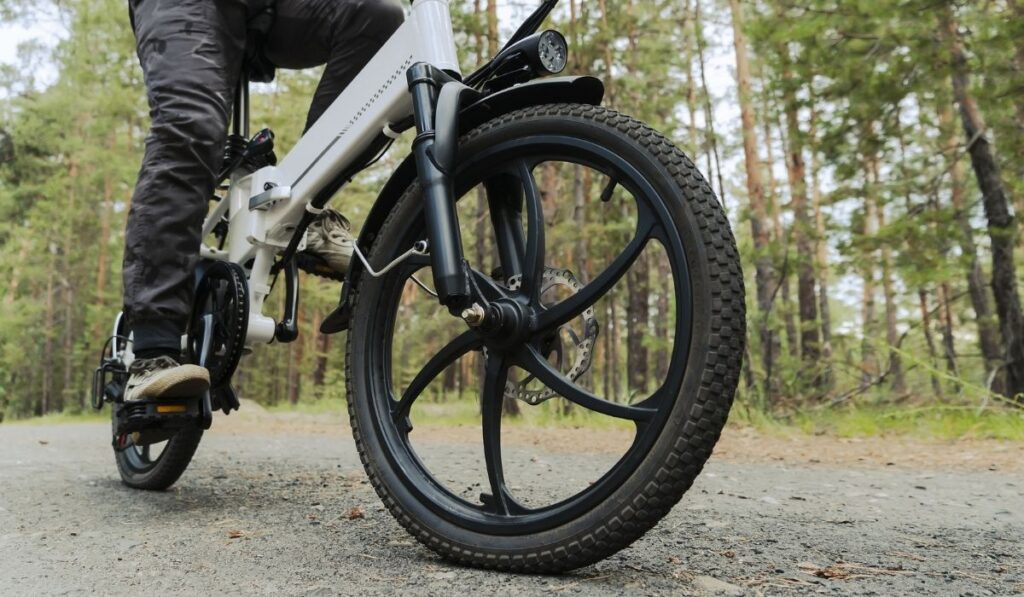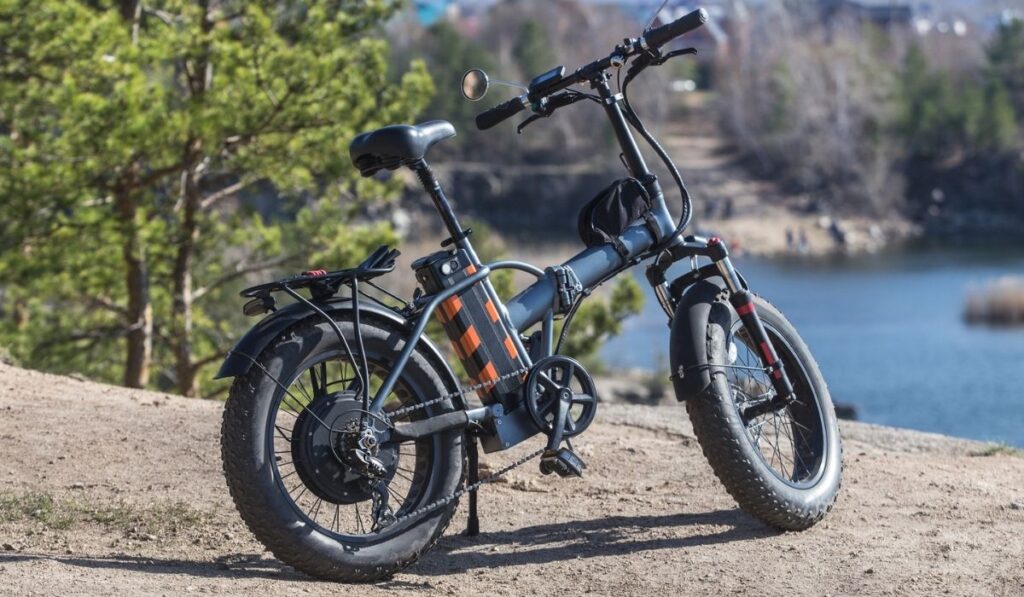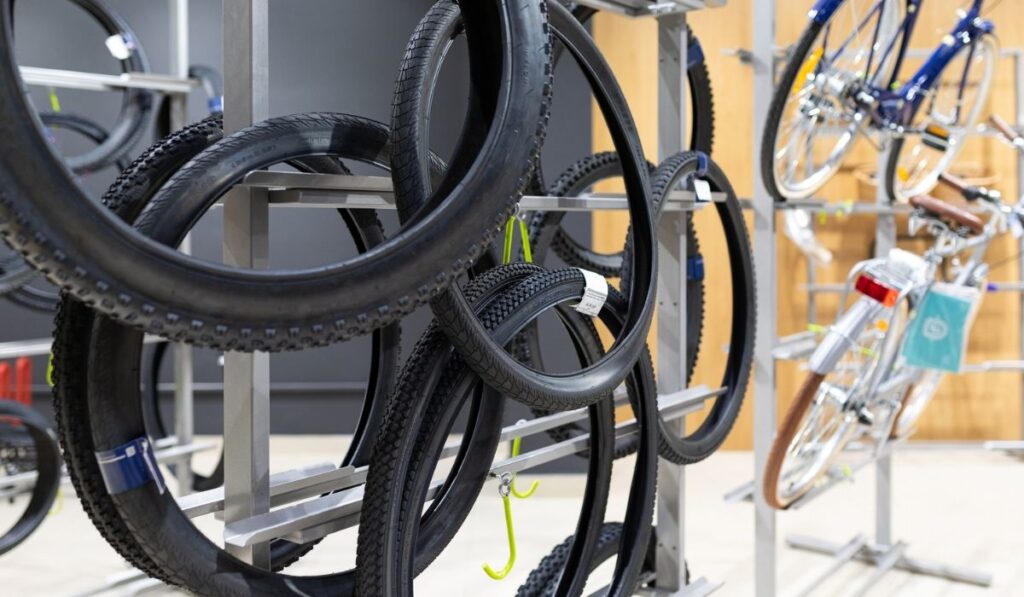Electric bikes are not the same as your grandparents’ bicycles! They’re a hybrid of sorts that assist you in pedaling with an electric, rechargeable battery and motor. This technology allows you to go further distances, faster, without exerting as much of your physical energy. One thing you’ll immediately about electric bikes is that, in addition to a hefty battery and motor, the tires seem to look different than traditional road or mountain bikes. What’s going on here?
E-bikes don’t need special tires, but some tires are designed specifically for e-bikes. They take advantage of the motor providing higher speed and torque than a person. Larger, thicker tires will last longer (some with ratings of up to 3k miles). Thin road bike tires will work but wear out faster.
Electric bikes are capable of much faster speeds than non-electric bikes. Due to their higher rates of speed, there are tires designed specifically for e-bikes that make their fast treks safer. These design considerations include better protection, thicker material, and higher speed ratings.
How E-Biking Effects Tire Differently

Tires are arguably the most important components of e-bikes. Without them, the electric bike would be useless. If they get damaged and worn easily or are of bad quality, the convenience and safety of the electric bike is radically diminished.
Compared to non-electric bikes, such as mountain bikes and road bikes, electric bikes experience more extreme conditions and higher speeds. Additionally, tires (along with the suspension) separate the rider from all the bumps, holes, and other obstacles along your path.
As such, there should be quality standards around tires for electric bikes. While many e-bike tire manufacturers in the U.S. have self-regulated safety standards, the government does not provide any regulation or certification from manufacturers.
However, it is a different case in Europe, which classifies electric bikes as mopeds. Their requirement is part of the United Nations Economic Commission for Europe. To pass European certification the electric bike tires must undergo specific tests and measurements, including:
- Dimensional measurements and labeling in proper ares
- Speed and load performance testing, the tire undergoes a simulated test at 25 or 50 kmh to determine if it fails
- Dynamic growth test, the dimensions are compared when the tire is speed tested to assess its stability
- Various tests and checks of tire components– bead, rim, ply, cord, tread, tread grove, sidewall, and carcass
With all these standards applied to electric bike tires in Europe, you might be thinking, “wow, I should make sure my e-bike has good tires.” But, in the U.S. how do you know what is good and what’s not without certifications and standards?
Well, for one, you can find reviews and feedback from other electric bikers. For two, you can buy European certified e-bike tires in the U.S. After all, electric bikes carry extra weight and are capable of higher speeds than regular bikes, so you should ensure the tires are safe.
How Are E-Bike Tires Treated Differently?
The main ways electric bikes tires are treated differently is the speeds they are capable of and their increased weight. For example, an electric bike can easily achieve speeds of 30 mph with an average rider. Compared to a road bike, an average person would be lucky to maintain 20 mph for more than a minute.
These high speeds, coupled with the increased weight of an electric bike (between 40 to 65 lbs), means the e-bike’s tires will have ongoing constant extra stress. As such, e-bike tires are pressed into the ground with more force, making the rubber wear down faster while braking and throughout the ride.
Therefore, you should never pick the cheapest e-bike tire you can find. Consider getting the largest volume tire that your e-bike’s fork can fit (like a fat tire); it will make riding the e-bike smoother, more enjoyable, and provide better traction.
Go for tires that have puncture protection and a 60 TPI (threads per inch) specification or higher.
Why are Some E-Bike Tires Very Thick?

To answer why some electric bike tires are very thick, let’s review why different types of bikes have different types of tires first. On the opposite end of the spectrum, road bike tires are very narrow and thin. They are like this to minimize the tire’s surface area touching the road, which reduces the overall friction.
Additionally, road bike tires are also very smooth, they have thin treads. Road bike tires are designed for smooth surfaces, such as pavement, and optimal speed. In other words, they are designed to reduce friction, to prevent lost energy.
Mountain bike tires are wider and have deeper treads, which means they will have more energy lost to the ground through friction than road bike tires. However, unlike road bike tires, they are designed to take more impact from holes and uneven terrain. Their deeper treads and width are needed to navigate off-road terrain.
Lastly, fat tires are designed with the maximum amount of surface area. As you might suspect, they have the most energy loss through friction with flat, paved surfaces– they work well in sand, snow, and wet conditions. With their wider base, they can churn through these environments where road and mountain bike tires would sink, leaving the rider spinning their tires like a hamster in a wheel.
Therefore, we can surmise that bike tires are designed to minimize friction to reduce energy loss, allowing the rider to pedal efficiently (without sacrificing usability in various terrains).
Now that we have the different tires explained let’s get back to why some e-bikes have wider tires. Since electric bikes are battery-powered, friction loss is less of a focus since not all of the energy comes from rider pedaling.
Therefore, e-bike riders are more willing to spend an arbitrarily large amount of energy from the battery to drive larger tires with better tires because they are safer. Along with better safety, larger tires on electric bikes make off-roading, gravel, dirt, mud, sand, snow, and most types of paths and conditions accessible.
Do You Need Special Tires for E-Bikes?

Compared to regular bicycles, electric bikes can achieve much faster rates of speed. Additionally, they are typically heavier, weighing between 40 to 60 pounds on average. Since they’re heavier and faster, you might correctly assume that electric bike tires work harder than tires on regular bikes.
However, if e-bike tires are put under more stress, are special tires required? In the United States, you don’t “need” special tires for your electric bike. However, most electric bikes come with more robust tires than a traditional bike by default.
When it comes time to replace your tire on your e-bike, it is best to stick with e-bike specific tires to reap their benefits. Tires designed specifically for e-bikes have a thicker casing and tread that can handle the friction and heat from faster rolling, provide better protection from punctures, and give a great cushion to curb hopping and potholes.
They also have thicker grooving that offers better traction at higher speeds, preventing slipping and the infamous “speed wobble” if you go too fast. All in all, tires designed for electric bikes have thicker materials and wider sizes. They provide better durability and are optimized for wear resistance, meaning they last many more miles than a traditional bike tire.
Again, e-bike specific tires are not a requirement, but since you’re traveling at high speeds and e-bike tires are more difficult to change, electric bikers should stick with e-bike tires.
What Makes a Tire Better for Electric Bikes?
As we’ve discussed, electric bike tires are designed to be more robust. But what exactly does that mean? So let’s get into the specifics and elaborate beyond the rubber being thicker.
Electric bike tires have the following improvements over regular bike tires:
- Higher TPI (threads per inch) – a larger TPI number means your e-bike tires will have a better overall grip on the road through turns, bumps, and any road condition you experience
- Thicker tread and casing – a stockier casing and treads means there is a larger amount of rubber between you and the road, which means it will take longer to wear down and will be less susceptible to puncturing.
- Thicker groves – deeper groves provide better handling in offroad and wet conditions.
- Higher temperature rating – since electric bikes travel at faster speeds, the friction from the tire continuously rolling on the road creates more heat necessitating a higher temperature rating.
- Higher pressure rating – e-bike tires are designed to absorb sudden, harsh impacts without popping from the resulting pressure spike.
What are the Best Tires for E-Bikes?
If you have an electric bike and you need replacements, there are plenty of options for you on the open market. Here are some of the best electric bike tires:
Schwalbe Marathon Plus
The Schwalbe Marathon Plus tire (on Amazon) is an excellent option for electric bikers that stick primarily to urban environments, in other words, mainly riding on pavement and cement. They have an outstanding 5 mm of puncture protection with their elastic, India rubber which also provides a comfortable ride feel.
Schwalbe designed the sidewalls to be reflective, adding a well-received layer of visibility and safety to the electric bike. The Marathon Plus has a performance line wire bead, which provides excellent quality and long life.
Maxxis Minion Fat Tire
The (Maxxis Minion fat tire on Amazon) is designed with dual-compound rubber that is compatible with most types of terrain, including sand, snow, dirt, and gravel. Due to its excessive width and side treads, it has excellent cornering capabilities. It has a smooth rolling feel and is available at a cost-competitive price.
Maxxis Hookworm Tire
The (Maxxis Hookworm BMX Tire on Amazon) has a curved grooved slick design, which is made for BMX activities in mind. So if you’re looking for an off-road or commuting tire, this isn’t for you. The Hookworm has a high-pressure rating of 65 PSI along with rim-to-rim tread-protected sidewalls, which enable it to be used in all the types of bouncing, sliding, and skidding that BMX activities bring.
Mongoose Fat Bike Tire
The Mongoose Fat Bike Tire (on Amazon) has an aggressive and knobby tread pattern, making it a fantastic choice for extreme conditions such as muddy paths, deep snow, sandy beaches, and gravel streets. Its tread pattern provides excellent gripping, especially in tight corners and steep trails.
Dues to its large volume, the rider barely notices potholes, roots, and other obstacles that the tire rolls over. The knobby tread pattern is designed for off-road conditions; using this tire excessively on paved roads can wear down the tire faster than expected.
How Long do E-Bike Tires Last?
Electric bikes are designed to go faster and longer distances than non-electric bikes. Their batteries add extra power, which spins the wheels faster than the rider could do on their own.
They are beneficial as they don’t wear the rider out as quickly and help them arrive at their destinations faster. But with the faster speeds and more robust tires, does that mean electric bike tires wear down faster or slower?
Electric bike tires last between 1,000 to 3,000 miles on average. This range is enormously large and highly dependent on the terrain conditions, type of tire, brand, and specific model. For example, the Schwalbe Marathon Plus has a lifespan of well over 1,500 miles on flat surfaces.
If you ride 20 miles a day and the tire lasts 2,000 miles, that means it will last 100 days or roughly three and a half months. However, if you use the same tire routinely on rocky terrain (which it is not designed for), it may last only half as long. Therefore, it is more important to select the proper tire for the conditions the electric bike will be experiencing.
